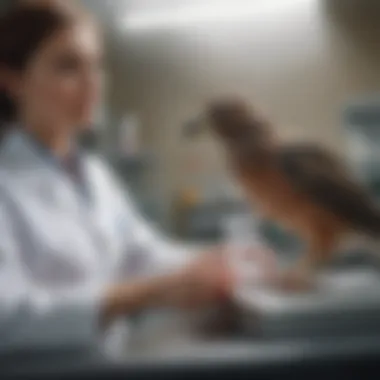Unveiling the Intricacies of Veterinary Assistant Annual Salaries


Market Insights
Economy Insights
Economic indicators and metrics provide valuable context for understanding the financial landscape for veterinary assistants. Government policies play a significant role in influencing wages and employment opportunities within the animal healthcare industry. Global economic news highlights the overall stability of the veterinary medicine sector, offering assurance to prospective assistants regarding long-term career prospects and income growth.
Investment Strategies
For aspiring veterinary assistants looking to optimize their earnings potential, portfolio diversification is key. By acquiring a diverse set of skills and certifications, individuals can position themselves for higher-paying roles within veterinary clinics and hospitals. Implementing risk management techniques, such as staying abreast of technological advancements in the healthcare field, can further boost job security and income stability. Effective evaluation criteria for potential employers ensure that salary negotiations are conducted from a position of knowledge and confidence.
Personal Finance Tips
Budgeting and saving strategies are crucial for veterinary assistants seeking financial stability and long-term wealth accumulation. By setting aside a portion of their income for emergencies and future investments, assistants can navigate unforeseen expenses with ease. Retirement planning guidance tailored to the unique challenges faced by individuals in the animal healthcare industry ensures a comfortable post-working life. Debt management tips offer practical advice on managing student loans or financing advanced education while maintaining a healthy financial profile.
Case Studies and Success Stories
Real-life examples of veterinary assistants who have navigated salary negotiations and career advancement provide invaluable insights for professionals in the field. Successful investment stories demonstrate how prudent financial planning can yield significant returns over time, inspiring others to make informed decisions about their earnings. Personal finance transformation journeys underscore the transformative power of strategic money management, showcasing the potential for individuals to achieve their financial goals through dedication and smart decision-making.
Introduction
Overview of Veterinary Assistants
Responsibilities and Duties
The responsibilities and duties of veterinary assistants encompass a wide range of tasks vital to the functioning of a veterinary clinic. From handling administrative duties like scheduling appointments and maintaining records to providing hands-on assistance during examinations and treatments, their role is multifaceted. These dedicated professionals are often the first point of contact for pet owners, offering guidance and reassurance during challenging times. Their ability to multitask, show empathy towards animals, and work seamlessly alongside veterinarians makes them indispensable in any veterinary setting.
Importance in Veterinary Care


The significance of veterinary assistants in the realm of animal care is profound. Their presence not only eases the workload of veterinarians but also ensures a higher standard of patient care. By acting as a bridge between pet owners and veterinary staff, they contribute to fostering positive relationships and establishing trust within the community. Their attention to detail, compassion towards animals, and strong work ethic make them valuable assets in promoting the overall well-being of pets. The dedication they bring to their work significantly impacts the quality of care provided in veterinary practices.
Purpose of the Article
Highlighting Salary Insights
In shedding light on the salary insights of veterinary assistants, this article aims to provide a clear understanding of the financial aspects associated with this profession. By exploring the factors that influence salaries, such as educational background, experience level, and geographic location, readers will gain a comprehensive view of the earning potential in this field. Understanding the nuances of salary structures and industry norms is essential for aspiring veterinary assistants and professionals looking to grow in their careers. By highlighting salary insights, this article equips individuals with the knowledge needed to make informed decisions regarding their career paths and financial futures.
Factors Influencing Veterinary Assistant Salaries
Educational Background
Certification and training are pivotal aspects of educational background that greatly affect a veterinary assistant's earning potential. Attaining relevant certifications and undergoing specialized training enhance the skill set and knowledge base of veterinary assistants, making them more valuable in the workplace. The certification process often includes theoretical coursework and practical training, equipping veterinary assistants with the expertise required to excel in their roles. Furthermore, continuing education and pursuing advanced certifications can lead to salary increments and career advancements within the field.
Certification and Training
The certification and training received by veterinary assistants are paramount to their success in the industry. Acquiring certifications demonstrates a commitment to professionalism and ongoing learning, traits highly valued in veterinary healthcare settings. Employers often prefer candidates with accredited certifications as they indicate a certain standard of quality and competence. Additionally, specialized training programs provide in-depth knowledge of specific areas within veterinary assistance, such as surgery support or emergency care, making certified professionals more versatile and adaptable to diverse work requirements.
Experience Level
Distinguishing between entry-level and senior positions is essential in understanding how experience level influences veterinary assistant salaries. Entry-level veterinary assistants typically receive lower compensation compared to their senior counterparts due to their limited practical experience and skill development. As professionals gain more hands-on experience and accumulate expertise in the field, their value to employers increases, resulting in higher pay and perks.
Entry-Level vs. Senior Positions
The differentiation between entry-level and senior positions lies in the depth of knowledge, proficiency, and leadership abilities demonstrated by veterinary assistants. Entry-level roles focus on foundational responsibilities and tasks, allowing individuals to familiarize themselves with essential job functions. In contrast, senior positions require seasoned professionals to handle complex cases, lead teams, and make critical decisions independently. The progression from entry-level to senior positions signifies growth in skills, competencies, and responsibilities, reflecting positively on salary prospects and career advancement.
Geographic Location
Geographic location significantly impacts salary disparitie..nces among veterinary assistants, as compensation rates vary across regions due to cost of living, demand for veterinary services, and local economic conditions. Understanding how location affects salary disparities is essential for veterinary assistants seeking competitive pay and favorable work environments.


Impact on Salary Disparities
The impact of geographic location on salary disparities is evident in the wide range of compensation packages offered to veterinary assistants in different areas. Urban centers with high living expenses tend to pay higher salaries to offset the cost of housing, transportation, and amenities. On the other hand, rural regions may offer lower salaries but provide a more relaxed pace of work and closer-knit communities. Considerations such as job market saturation, population demographics, and industry demand play a significant role in determining salary levels based on geographic location.
Average Salaries of Veterinary Assistants
When it comes to understanding the financial landscape of veterinary assistants, focusing on the average salaries becomes imperative. Delving into the realm of average salaries provides a comprehensive view of the compensation these professionals receive. It offers crucial insights into the financial aspects of pursuing a career as a veterinary assistant, shedding light on the remuneration and rewards associated with this vital role in animal healthcare. Exploring the average salaries of veterinary assistants allows individuals interested in this field to gauge the potential earnings, motivating them to pursue this career path.
National Average
Annual Median Salary
The heart of the national average salary for veterinary assistants lies in the annual median salary. This specific aspect plays a pivotal role in shaping the overall understanding of the earning potential in this profession. The annual median salary represents the midpoint of all salaries earned by veterinary assistants, providing a clear indicator of the typical income one can expect in this role. It is a reliable benchmark for both aspiring and practicing veterinary assistants to assess their earning capacity and set realistic financial goals. The annual median salary stands out as a popular choice for analysis in this article due to its significant impact on the perception and attractiveness of the veterinary assistant profession.
In examining the unique features of the annual median salary, its consistency and stability come to the forefront. The annual median salary offers a steady income reference point for veterinary assistants, enabling them to plan their finances effectively. While it may not account for outliers or extreme variations in salaries, the annual median salary serves as a robust indicator of the typical earnings in this field. Understanding the annual median salary is advantageous for readers of this article as it provides a centralized figure that reflects the standard remuneration for veterinary assistants.
Regional Disparities
Variations Across States
Diving deeper into the average salaries of veterinary assistants, exploring the variations across states unveils a nuanced perspective on the financial landscape in this profession. Regional disparities play a significant role in influencing the earning potential of veterinary assistants, highlighting the diverse economic conditions and cost of living factors across different states. Analyzing the variations across states allows for a comprehensive analysis of the salary differences that exist among veterinary assistants practicing in various geographical locations.
The key characteristic of variations across states lies in the disparity in living expenses and demand for veterinary services in different regions. This aspect is pivotal in understanding why salaries may fluctuate based on the location of employment. It offers valuable insights into the economic dynamics affecting the compensation packages of veterinary assistants, enabling readers to grasp the contextual factors influencing salary discrepancies. By examining the variations across states, readers can gain a nuanced understanding of the regional nuances that impact the average salaries of veterinary assistants.
Industry Variances
Comparative Salaries in Different Settings
Another essential facet of exploring the average salaries of veterinary assistants is investigating the comparative salaries in different settings within the industry. Understanding the salary discrepancies based on the employment setting provides valuable insights into the various career pathways available to veterinary assistants. Comparative salaries in different settings offer a holistic view of the financial prospects in roles such as working in private clinics, animal hospitals, research facilities, or government agencies.


The key characteristic of comparative salaries in different settings is the diversity in earning potentials and job responsibilities across various sectors of the veterinary industry. This aspect sheds light on the financial rewards associated with different professional environments, allowing individuals to make informed decisions regarding their career choices. By delving into the comparative salaries in different settings, readers can explore the unique advantages and disadvantages of pursuing a career as a veterinary assistant in different employment contexts.
Career Growth Opportunities
In the realm of veterinary assistance, career growth opportunities hold paramount significance. As one navigates the landscape of this profession, understanding the avenues for advancement is crucial. Veterinary assistants, integral to the functioning of animal healthcare facilities, can explore various paths to enhance their skills, broaden their knowledge base, and elevate their career trajectory. Career growth in this field is not just about climbing the organizational ladder but also about personal and professional development, potentially leading to higher job satisfaction and financial rewards. By delving into these opportunities, professionals can chart a course for long-term success in the veterinary industry.
Advancement Paths
Specializations and Career Progression
Specialization plays a pivotal role in the professional growth of veterinary assistants. By honing in on specific areas such as surgical assistance, laboratory procedures, or exotic animal care, assistants can develop expertise that sets them apart in the field. Specializing enhances job performance, instills confidence, and opens doors to more specialized roles with increased responsibilities and remuneration. The unique feature of specialization lies in its ability to cater to individual interests and strengths, allowing for a customized career path tailored to one's passions and skills. While specialization brings benefits like niche job opportunities and enhanced job satisfaction, it may also limit flexibility compared to generalist roles. Nonetheless, for those passionate about a particular facet of veterinary care, specialization offers a roadmap to professional fulfillment.
Salary Prospects
Navigating the landscape of salary prospects is vital in understanding the tangible outcomes of career growth for veterinary assistants. By pursuing advancement opportunities and acquiring specialized skills, professionals can leverage their expertise to increase their earning potential. The key characteristic of exploring salary prospects lies in the possibility of financial growth and stability. As individuals garner experience, skills, and qualifications, they position themselves for higher paying roles within the veterinary industry. This inherently beneficial choice aligns with the overarching goal of this article, shedding light on the financial aspects of a career as a veterinary assistant. While the unique feature of salary prospects lies in their direct correlation to career progression and skill development, they also come with the challenge of balancing monetary incentives with personal fulfillment. Ultimately, understanding and maximizing one's salary prospects is a pivotal component of crafting a successful and rewarding career journey.
Additional Benefits and Perks
In the narrative of veterinary assistants' annual salaries, the section on Additional Benefits and Perks plays a crucial role in illustrating the comprehensive nature of the compensation package for individuals in this field. Beyond the monetary aspect, these additional benefits serve as incentives and rewards for the dedication and hard work put in by veterinary assistants. They enhance the overall job satisfaction and employee retention rates in veterinary practices. By offering a glimpse into the perks beyond just the salary component, readers can understand the holistic approach employers take in valuing their employees.
Healthcare Benefits
In dissecting the healthcare benefits provided to veterinary assistants, the focus narrows down to the specifics of insurance coverage. Insurance plays a pivotal role in ensuring the well-being and security of these professionals. By delving into the intricacies of insurance coverage, this section sheds light on the safety net it provides in the event of unforeseen circumstances. Additionally, it highlights the proactive approach of employers in safeguarding the health and financial welfare of their staff. The discussion of insurance coverage underscores the emphasis placed on employee health and the employer's responsibility towards their team members.
Insurance Coverage
A cornerstone of the healthcare benefits enjoyed by veterinary assistants, insurance coverage stands out as a critical component in their overall compensation package. This coverage extends beyond mere medical expenses, encompassing various aspects such as dental, vision, and disability benefits. The versatile nature of insurance coverage ensures that employees have access to a comprehensive range of healthcare services, promoting a sense of security and well-being. Its flexibility in accommodating diverse needs and preferences makes it a valuable and popular choice among veterinary assistant professionals. The advantages of insurance coverage lie in its ability to mitigate financial risks associated with healthcare emergencies, providing a safety net that offers peace of mind and stability to employees.
Work-Life Balance
Within the realm of maintaining a healthy work-life balance, the spotlight falls on the significance of flexible schedules for veterinary assistants. Flexible schedules act as a cornerstone in promoting a harmonious equilibrium between professional responsibilities and personal aspirations. By exploring the implications of flexible work arrangements, this section showcases the accommodating nature of veterinary practices towards the varying needs of their employees. The discussion surrounding work-life balance underscores the value placed on employee well-being and productivity within the veterinary care environment.
Flexible Schedules
An integral feature in promoting work-life balance, flexible schedules empower veterinary assistants to tailor their work hours according to personal obligations and preferences. This adaptability allows for greater control over one's daily routine, fostering a sense of autonomy and efficiency in task management. The unique aspect of flexible schedules lies in its ability to accommodate diverse lifestyles, enhancing job satisfaction and overall quality of life for employees. While presenting numerous advantages such as reduced stress levels and improved job performance, flexible schedules may pose challenges in terms of maintaining standard operational hours and ensuring seamless workflow within the practice setting. However, the benefits of enhanced work-life balance outweigh these potential drawbacks, making flexible schedules a pivotal element in shaping a conducive and gratifying work environment for veterinary assistants.



